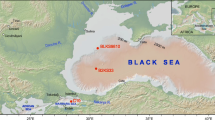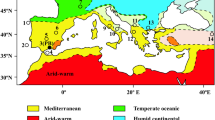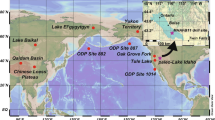Abstract
Pollen records from 21 sites were used to reconstruct Holocene hydrological changes in northern Fennoscandia. The inferred dominance of maritime-type Betula-forests from c. 9600 BP onwards indicate an oceanic climate in the region during the early Holocene, with high amounts of precipitation and low seasonal contrasts. This interpretation is supported by oxygen isotope records obtained on lacustrine carbonates from Abisko, northern Sweden. Enrichment of 18O during the early Holocene suggests enhanced zonal circulation and a pronounced influence of Atlantic air-masses in northern Sweden. The pattern of Pinus expansion in the area was time-transgressive, ranging from 9200-8000 BP in the extreme north-east to 7900-5500 BP in the western and south-western parts of the region. The replacement of Betula-forests by Pinus-forests indicates a climatic change towards drier summers and increased seasonality. At Abisko, a close correlation between regional Pinus expansion and depletion of 18O in lacustrine carbonates suggests that the expansion of Pinus was triggered by a gradual attenuation of the influence of westerlies. Thus, in large-scale palaeohydrological terms, the early expansion of Pinus in the north-easternmost parts of Fennoscandia as compared to the successively later expansion in the west and south-west may reflect a gradually decreasing influence of Atlantic air-masses in northern Fennoscandia during the early and mid Holocene.
Similar content being viewed by others
References
Aario, L., 1943. Ñber die Wald-und Klimaentwickliung an der lappländischen Eismeerküste in Petsamo, mit einem Beitrag zur nord-und mitteleuropäischer Klimageschichte. Ann Bot. Soc. Zool. Bot. Fenn. ‘Vanamo’ 19: 1–158.
Arvola, E., 1987. Suomen ilmastoon vaikuttavat ilmavirtausjärjestelmät ja säätyypit. In Alalammi, P. (ed.), Atlas of Finland. Folio 1231 Climate. National Board of Survey & Geographical Society of Finland, Helsinki, 22–23.
Barnekow, L., 1999a. Holocene vegetation dynamics and climate changes in the Törneträsk area, northern Sweden. Thesis 43, Department of Quaternary Geology, Lund University, 30 pp.
Barnekow, L., 1999b. Holocene tree-line dynamics and inferred climatic changes in the Abisko area, northern Sweden, based on macrofossil and pollen records. The Holocene 9: 253–265.
Barnekow, L., G. Possnert & P. Sandgren, 1998. AMS 14C chronologies of Holocene lake sediments in the Abisko area, northern Sweden – a comparison between dated bulk sediment and macrofossil samples. GFF 120: 59–67.
Berglund, B. E., L. Barnekow, D. Hammarlund, P. Sandgren & I. F. Snowball, 1996. Holocene forest dynamics and climate changes in the Abisko area, northern Sweden – The Sonesson model of vegetation history reconsidered and confirmed. Ecol. Bull. 45: 15–30.
Bliss, L. C., 1981. North American and Scandinavian tundras and polar deserts. In Bliss, L. C., O. W. Heal & J. J. Moore (eds), Tundra Ecosystems: A Comparative Analysis. Cambridge University Press, Cambridge: 8–24.
Bliss, L. C. & N. V. Matveyeva, 1992. Circumpolar Arctic Vegetation. In Chapin, F. S., R. L. Jeffries, J. F. Reynolds, J. F., G. R. Shaver & J. Svoboda (eds), Arctic Ecosystems in a Changing Climate. Academic Press, San Diego, 59–89.
Donner, J., P. Alhonen, M. Eronen, H. Jungner & I. Vuorela, 1978. Biostratigraphy and radiocarbon dating of the Holocene lake sediments of Työtjärvi and peats in the adjoining bog Varrassuo, west of Lahti in southern Finland. Ann. Bot. Fenn. 15: 258–280.
Edlund, S. A., 1983. Bioclimatic zonation in a High Arctic region: Central Queen Elizabeth Island. Geological Survey of Canada, Paper 83 – 1A: 381–390.
Eronen, M., 1979. The retreat of pine forest in Finnish Lapland since the Holocene climatic optimum: A general discussion with radiocarbon evidence from subfossil pines. Fennia 157: 93–114.
Eronen, M. & H. Hyvärinen, 1982. Subfossil pine dates and pollen diagrams from northern Fennoscandia. GFF 103: 437–445.
Eronen, M. & P. Huttunen, 1993. Pine megafossils as indicators of Holocene climatic changes in Fennoscandia. Paläoklimaforschung – Palaeoclimate Research 9: 9–40.
Eronen, M. & P. Zetterberg, 1996. Climatic Changes in Northern Europe Since Late Glacial Times, with special reference to dendroclimatological studies in northern Finnish Lapland. Geophysica 32: 35–60.
Etherington, J. R., 1982. Environment and Plant Ecology. John Wiley, Chichester. 487 pp.
Haapasaari, M., 1988. The oligotrophic heath vegetation in northern Fennoscandia and its zonation. Acta Bot. Fenn. 135: 1–219.
Hämet-Ahti, L., 1963. Zonation of the mountain birch forests in northernmost Fennoscandia. Ann. Bot. Soc. ‘Vanamo’ 34: 1–127.
Hammarlund, D., R. Aravena, L. Barnekow, B. Buchardt & G. Possnert, 1997. Multi-component carbon isotope evidence of early Holocene environmental change and carbon-flow pathways from a hardwater lake in northern Sweden. J. Paleolim. 18: 219–233.
Hammarlund, D. & T. W. D. Edwards, 1998. Evidence of changes in moisture transport efficiency across the Scandes mountains in northern Sweden during the Holocene, inferred from oxygen isotope records of lacustrine carbonates. Proceedings of an International Symposium on Isotope Techniques in the Study of Past and Current Environmental Changes in the Hydrosphere and the Atmosphere. IAEA, Vienna 14– 18 April, 1997, IAEA-SM-349/40, 573–580.
Hammarlund, D., T. W. D. Edwards, S. Björck, B. Buchardt & B. Wohlfart, 1999. Climate and environment during the Younger Dryas (G5-1) as reflected by composite isotope records of lacustrine carbonates at Torreberga, southern Sweden. J. Quat. Sci. 14: 17–28.
Huntley, B. & I. C. Prentice, 1993. Holocene vegetation and climates of Europe. In Wright, H. E. Jr., J. E. Kutzbach, T. Webb III, W. F. Ruddiman, F. A. Street-Perrott & P. J. Bartlein (eds), Global Climates since the Last Glacial Maximum. University of Minnesota Press, Minneapolis, 136–168.
Hyvärinen, H., 1975. Absolute and relative pollen diagrams from northernmost Fennoscandia. Fennia 142: 1–23.
Hyvärinen, H., 1976. Flandrian pollen deposition rates and tree-line history in northernmost Fennoscandia. Boreas 5: 163–175.
Hyvärinen, H., 1985. Holocene pollen history of the Alta area, an isolated pine forest north of the general pine forest region in Fennoscandia. Ecologia Mediterranea, Tome XI (Fascicule 1), 69–71.
Hyvärinen, H. & P. Alhonen, 1994. Holocene lake-level changes in the Fennoscandian tree-line region, western Finnish Lapland: Diatom and cladoceran evidence. The Holocene 4: 251–258.
Kane, D. L., L. D. Hinzman, M.-K. Woo & K. R. Everett, 1992. Arctic hydrology and climate change. In Chapin, F. S., R. L., Jeffries, J. F. Reynolds, G. R. Shaver & J. Svoboda (eds), Arctic Ecosystems in a Changing Climate. Academic Press, San Diego, 35–57.
Karlén, W., 1988. Scandinavian glacial and climatic fluctuations during the Holocene. Quat. Sci. Rev. 7: 199–209.
Koç , N., E. Janssen & H. Haflidason, 1993. Paleoceanographic reconstructions of surface ocean conditions in the Greenland, Icelandic and Norwegian Seas through the last 14 ka based on diatoms. Quat. Sci. Rev. 12: 115–140.
Korhola, A., 1995. Holocene climatic variations in southern Finland reconstructed from peat-initiation data. The Holocene 5: 43–58.
Kullman, L., 1979. Change and stability in the altitude of the birch tree-limit in the southern Swedish Scandes 1915– 1975. Acta Phytogeogr. Suec. 65: 1–121.
Kullman, L., 1986. Late Holocene reproductional patterns of Pinus sylvestris and Picea abies at the forest limit in central Sweden. Can. J. Bot. 64: 1682–1690.
Kullman, L., 1992. Orbital forcing and tree-limit history: Hypothesis and preliminary interpretation of evidence from Swedish Lappland. The Holocene 2: 131–137.
Kullman, L., 1993. Holocene thermal trends inferred from tree-limit history in the Scandes Mountains. Global Ecol. Biogeogr. Lett. 2: 181–188.
Kullman, L., 1995. Holocene tree-limit and climate history from the Scandes mountains, Sweden. Ecology 76: 2490–2502.
Kullman, L., 1999. Early Holocene tree growth at a high elevation site in the northernmost scandes of Sweden (Lapland): A palaeobiogeographical case study based on megafossil evidence. Geog. Ann. 81A: 63–74.
Kutzbach, J. E., 1987. Model simulations of the climatic patterns during the deglaciation of North America. In Ruddiman, W. F. & H. E. Wright (eds), North America and Adjacent Oceans During the Last Deglaciation. Geol. Soc. Am., Boulder, Colorado, USA: 426–446.
Kutzbach, J. E., P. J. Guetter, P. J. Behling & R. Selin, 1993. Simulated Climatic Changes: Results of the COHMAP Climate-Model Experiments. In Wright, H. E. Jr., J. E. Kutzbach, T. Webb III, W. F. Ruddiman, F. A. Street-Perrott & P. J. Bartlein (eds), Global Climates Since the Last Glacial Maximum. University of Minnesota Press, Minneapolis, 24–93.
Laaksonen, K., 1979. A real distribution of monthly mean air temperatures in Fennoscandia (1921-1950). Fennia 157: 89–124.
Lindström, M., J. Lundqvist & T. Lundqvist, 1991. Sveriges geologi frå n urtid till nutid. Student litteratur, Lund. 398 pp.
Lundqvist, J., 1998. Weichsel-istidens huvudfas. In Fredén, C. (ed.) Berg och Jord. National Atlas of Sweden. Stockholm, 124–135.
MacDonald, G. M., R. P. Beukens & W. E Kieser, 1991. Radiocarbon dating of limnic sediments: A comparative analysis and discussion. Ecology 72: 1150–1155.
MacDonald, G. M., T. W. D. Edwards, K. A. Moser, R. Pienitz & J. P. Smol, 1993. Rapid response of treeline vegetation and lakes to past climate warming. Nature 361: 243–246.
Mäkelä, E., K. Sarmaja-Korjonen & H. Hyvärinen, 1994. Holocene forest history of the Pöyrisjärvi area north of the coniferous tree line in western Finnish Lapland: A pollen stratigraphical study. Bull. Geol. Soc. Finl. 66: 81–94.
Matthews, J. A., 1978. Plant colonisation patterns on a gletchernvorfeld, southern Norway: A mesoscale geographical approach to vegetation change and phytometric dating. Boreas 7: 155–178.
Moore, P. D., J. A. Webb & M. E. Collinson, 1991. Pollen analysis. Cambridge University Press, Cambridge. 216 pp.
Nordseth, K., 1987. Climate and hydrology of Norden. In Varjo, U. & W. Tietze (eds), Norden. Man and Environment. Gebrüder Borntroeger, Berlin, 120–128.
Prentice, H. C., 1981. A late Weichselian and early Flandrian pollen diagram from Østervatnet, Varanger Peninsula, NE Norway. Boreas 10: 53–70.
Prentice, H. C., 1982. Late Weichselian and early Flandrian vegetational history of Varanger Peninsula, northeast Norway. Boreas 11: 187–208.
Rannie, W. F., 1986. Summer air temperature and number of vascular species in Arctic Canada. Arctic 39: 133–137.
Roberts, N. & H. E. Wright, Jr., 1993. Vegetational, lake-level and climatic history of the Near East and Southwest Asia. In Wright, H. E. Jr., J. E. Kutzbach, T. Webb III, W. F. Ruddiman, F. A. Street-Perrott & P. J. Bartlein (eds), Global Climates since the Last Glacial Maximum. University of Minnesota Press, Minneapolis: 194–220.
Ruuhijärvi, R., 1963. Zur Entwicklungsgeschichte der nordfinnischen Hochmoore. Ann. Bot. Fenn. Soc. Zool. Bot. Fenn. ‘Vanamo’ 34: 1–40.
Saarnisto, M., 1973. Contributions to the late-Quaternary history of the Lutto river valley, Finnish Lapland. Commentationes Physico-Mathematicae 43: 1–20.
Seppä, H., 1996. Post-glacial dynamics of vegetation and tree-lines in the far north of Fennoscandia. Fennia 174: 1–96.
Seppälä, M., 1971. Evolution of eolian relief of the Kaamasjoki-Kiellajoki river basin in Finnish Lapland. Fennia 104: 1–88.
Sollid, J. L., S. Andersen, N. Hamre, O. Kjeldsen, O. Salvigsen, S. Sturöd, T. Tweita & A. Wilhelmsen, 1973: Deglaciation of Finnmark, North Norway. Norsk Geografisk Tidskrift 27: 233–325.
Sonesson, M., 1968. Pollen zones at Abisko, Torne Lappmark, Sweden. Bot. Not. 121: 491–500.
Sonesson, M., 1974. Late Quaternary development of the Torneträsk area, north Sweden: 2. Pollen analytical evidence. Oikos 25: 288–307.
Sorsa, P., 1965. Pollenanalytische Untersuchungen zur spätquartären Vegetations – und Klimaentwicklung im östlichen Nordfinnland. Ann. Bot. Fenn. 2: 301–413.
Thompson, R. S., C. Whitlock, P. J. Bartlein, S. P. Harrison & W. G. Spaulding, 1993. Climatic changes in the western United States since 18,000 yrs. In Wright, H. E. Jr., J. E. Kutzbach, T. Webb III, W. F. Ruddiman, F. A. Street-Perrott & P. J. Bartlein (eds), Global Climates since the Last Glacial Maximum. University of Minnesota Press, Minneapolis: 468–513.
Tutin, T. G., N. A. Burges, A. O. Chater, J. R. Edmondson, V. H. Heywood, D. M. Moore, D. H. Valentine, S. M. Walter & D. A Webb, 1993. Flora Europaea I– V. 2. ed. Cambridge University Press, Cambridge.
Walker, D. A, E. Binnian, B. M. Evans, N. D. Lederef, E. Nordstrand & J. Webber, 1989. Terrain, vegetation, and landscape evolution of the R4D research site, Brooks Range Foothills, Alaska. Holarc. Ecol. 12: 238–261.
Vetaas, O. R., 1994. Primary succession of plant assemblages on a glacier foreland – Bø dalsbreen, southern Norway. J. Biogeogr. 21: 297–308.
Woodward, F. I., 1987. Climate and plant distribution. Cambridge University Press, Cambridge, 174 pp.
Wright Jr., H. E., 1976. The dynamic nature of Holocene vegetation. A problem in paleoclimatology, biogeography, and stratigraphical nomenclature. Quat. Res. 6: 581–596.
Zetterberg, P., M. Eronen & K. R. Briffa, 1994. Evidence on climatic variability and prehistoric activities between 165 B.C. and A.D. 1400 derived from subfossil Scots pines (Pinus sylvestris L.) found in a lake in Utsjoki, northernmost Finnish Lapland. Bull. Geol. Soc. Finl. 66: 107–124.
Author information
Authors and Affiliations
Rights and permissions
About this article
Cite this article
Seppä, H., Hammarlund, D. Pollen-stratigraphical evidence of Holocene hydrological change in northern Fennoscandia supported by independent isotopic data. Journal of Paleolimnology 24, 69–79 (2000). https://doi.org/10.1023/A:1008169800682
Issue Date:
DOI: https://doi.org/10.1023/A:1008169800682




